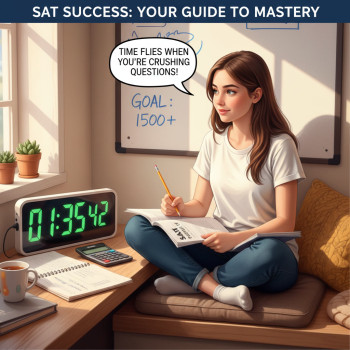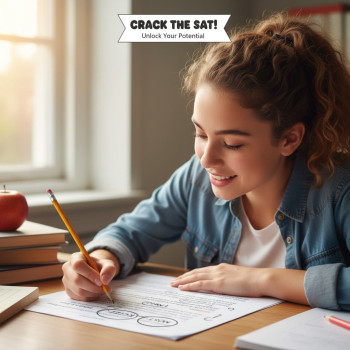Introduction: Why this balancing act matters
Parents: you’ve watched your teen sprint from one demanding class to another, lugging lab reports, extended essays, and problem sets home alongside a stack of college planning brochures. The International Baccalaureate (IB) and Advanced Placement (AP) programs are rigorous by design — they teach discipline, critical thinking, and deep subject knowledge. Add in the Digital SAT, and it can feel like your teen is training for two marathons at once.
This post is for families who want realistic, compassionate, and research-aligned advice for helping a teen thrive academically without burning out. I’ll walk through practical scheduling, communication strategies, study techniques, and stress-management tools — plus how targeted, personalized help, like one-on-one tutoring from Sparkl, can plug into your teen’s life in a healthy, efficient way.
Know the landscape: what IB/AP + Digital SAT really looks like
Before you design schedules or carve out study time, understand the core tensions. IB and AP classes often demand long-term, cumulative work: extended essays, lab write-ups, project portfolios, and end-of-course exams. The Digital SAT, meanwhile, is a high-stakes standardized test that rewards test-taking endurance, strategy, and consistent practice with the digital testing format.
Why that matters for planning:
- IB/AP deadlines are distributed and sometimes brutal — a big assignment or internal assessment can suck up a week or two.
- SAT prep benefits from consistent, spaced practice more than last-minute cramming.
- Digital delivery changes test experience: there’s time-management differences, interface navigation, and the built-in calculator for all math questions.

Quick baseline checklist for parents
- Confirm the SAT dates your teen is aiming for and the registration deadlines.
- Map major IB/AP milestones — internal assessment due dates, mock exams, and AP/IB final exam windows.
- Ask your teen how many hours of homework they average per week in each course and which assignments stress them most.
- Decide together on reasonable priorities (e.g., an immediate deadline takes precedence over an SAT practice session that can be rescheduled).
Design a flexible, realistic schedule
A schedule should be a scaffold, not a straightjacket. Teens need autonomy, so co-create a plan that fits their rhythms and school calendar. The goal: regular SAT practice embedded into the larger flow of their IB/AP obligations.
Weekly planning framework
Here’s a sample weekly structure that balances coursework with SAT prep. Adjust durations for your teen’s specific load.
| Day | IB/AP Tasks | SAT-Focused Tasks | Self-Care / Buffer |
|---|---|---|---|
| Monday | 2–3 homework blocks; review class notes (60–90 min) | 30–45 min targeted practice (e.g., math problem types) | 30 min exercise or downtime |
| Tuesday | Project work / lab write-up (60–120 min) | 30 min reading comprehension drills | 15–30 min family check-in |
| Wednesday | Class revision / flashcards (45–60 min) | 1 full practice section (timed) or 45 min on Bluebook/Khan Academy | 30–60 min hobby time |
| Thursday | Peer review / group study (60–90 min) | 30 min grammar/writing skill focus | Wind-down routine |
| Friday | Catch-up / assignments (60 min) | Light, untimed practice or review cards (20–30 min) | Social time / weekend launch |
| Saturday | 2–3 hour deep work block for major assignments | 1 full practice test or a longer timed session (if energy allows) | Long break / family time |
| Sunday | Review & plan week ahead (60–90 min) | Active review of mistakes from the week (30–60 min) | Rest and recharge |
Note: When an IB or AP deadline is imminent, reduce or pause SAT practice for short, intense bursts focused entirely on the coursework. The SAT comes back into play once the pressure event passes.
Make study sessions smarter — not necessarily longer
Effective study uses intention. Short, focused sessions beat marathon study blocks that leave a teen exhausted.
High-impact SAT practice techniques
- Active review of mistakes: When your teen finishes a practice section, spend time understanding why each missed question was missed — content gap, careless error, or timing issue.
- Quality over quantity: 30–45 minutes of deliberate practice (timed sections, strategy drills) three to five times a week often beats a single 3-hour weekend session.
- Use digital tools smartly: Practice on the same or similar interface to the test (Bluebook and official digital practice) so your teen becomes comfortable with navigation and timing.
- Mix skills: Rotate between reading, writing, and math within a week so all skills get steady attention.

Integrating SAT prep into IB/AP study
Look for natural overlaps. For example:
- AP English Language essays and IB Higher Level research essays can strengthen writing clarity and argumentation for SAT Writing.
- AP Calculus problem sets and IB Mathematics HL practice are excellent preparation for advanced SAT Math items — especially if practice includes timing and calculator fluency.
- Subject reading in sciences and humanities improves critical reading stamina for SAT passages.
Encourage your teen to use class notes as a source of content for SAT vocabulary and reading practice. That way, studying IB/AP material doubles as SAT enrichment.
Support without becoming the project manager
Parents often want to do everything: schedule, nag, coach, and fix. Instead, aim to be a steady resource — an accountability partner, not a micromanager.
Communication habits that help
- Weekly check-ins: Short, predictable conversations (15–20 minutes) to review the week’s wins, struggles, and the plan ahead.
- Problem-focus not score-focus: Ask what’s blocking them rather than just asking about scores. “What took you the longest this week?” prompts problem-solving; “What did you score?” can raise stress.
- Be curious: Ask how study methods feel. If timed practice raises anxiety, brainstorm coping strategies or consider switching the order of practice sessions.
- Negotiate flexibility: If a major IB internal assessment drops, agree to adapt the SAT schedule temporarily and map a clear return plan.
Stress, sleep, and the science of performance
Grades and scores are important, but cognitive science is clear: sleep, nutrition, and emotional regulation heavily influence memory consolidation and test performance. Your teen’s brain needs consistent sleep and restorative downtime to convert practice into improvement.
Practical self-care rules
- Prioritize sleep: Aim for a consistent bedtime that allows 8–9 hours for most teens — even during heavy study weeks.
- Short movement breaks: 10–20 minutes of physical activity boosts focus more effectively than extra study time when fatigue sets in.
- Mindful breathing or 5-minute resets: Use simple breathing techniques before a timed SAT section to reduce adrenaline and sharpen attention.
- Balanced diet & hydration: Regular snack breaks with protein and complex carbs sustain focus for long study sessions.
When to bring in extra help: tutors, teachers, and targeted resources
Not every student needs weekly tutoring. But targeted support can be transformative when used strategically: to shore up a specific content gap, to build test strategy, or to create accountability during busy IB/AP seasons.
How to evaluate tutoring fit
- Clarity of goals: Is the tutor focused on a particular weakness (e.g., algebra fluency, SAT reading strategies) or offering general support?
- Personalization: Does the tutor create a plan tailored to the teen’s schedule and IB/AP load, or do they offer a one-size-fits-all curriculum?
- Short, measurable cycles: Try a 6–8 session block. Look for measurable improvement in timing, accuracy, or confidence, not just test scores.
- Communication with parents: Tutors who offer succinct progress updates can help parents support without micromanaging.
For many families, Sparkl’s personalized tutoring model fits well: one-on-one guidance that builds a tailored study plan around a student’s IB/AP calendar, expert tutors who understand content overlap, and AI-driven insights that highlight which question types need the most attention. When a teen is juggling extended essays or scheduled lab work, such targeted support can keep SAT prep steady without adding chaos.
Smart tactics for peak weeks (exam season, big IA deadlines)
There will be weeks where IB or AP work consumes your teen’s mental bandwidth. Here’s how to keep the SAT train moving without overloading them.
Conserve energy with low-friction activities
- Micro-practice: 10–20 minute untimed drills — vocab cards, a single reading passage, or quick math problem sets.
- Passive exposure: Listen to an SAT-aligned vocabulary podcast or audio reading during commutes.
- Recovery focus: Emphasize sleep and nutrition. A well-rested brain retains more than a tired one after a 3-hour cram session.
When to pause and when to push
If a major IB deadline demands an all-hands-on-deck week, pause intensive SAT practice and use micro-sessions. But if the SAT test date is within 4–6 weeks of intense coursework, consider light, strategic maintenance practice to avoid skill erosion — short timed sections and targeted mistake review.
Practice tests: how often, and how to debrief them
Full-length practice tests remain the single most reliable predictor of test-day readiness. But they’re only valuable if followed by a disciplined review.
A practical testing cadence
- Early phase (3–6 months out): One full practice test every 2–3 weeks, focusing on pacing and stamina.
- Mid phase (1–3 months out): One full practice test weekly, with deeper error analysis.
- Final month: Two full practice tests per week if energy allows; otherwise maintain a steady one per week and emphasize quality review.
Debrief checklist after each practice test
- Record raw timing and score for each section.
- Categorize missed questions by cause: content gap, careless mistake, or timing pressure.
- Create a short action plan: 2–3 targeted drills to fix the most common error types that week.
- Celebrate wins — stamina improvements, fewer careless errors, or better time distribution.
College applications and timing: where the SAT fits
Work with your teen to decide realistic target scores, keeping in mind that colleges review applications holistically. Strong IB/AP performance, thoughtful extracurriculars, compelling essays, and teacher recommendations all matter. For many applicants, a solid SAT score plus standout IB/AP coursework communicates rigor and readiness.
Timing points to consider
- Most students take the SAT at least once in junior year and again early senior year if they want to improve scores.
- If your teen is enrolled in many AP/IB exams in May, prioritize those months for coursework and plan SAT dates earlier in spring or later in summer when the school load is lighter.
- Use official digital practice to time device-based testing and to become comfortable with the platform before test day.
Real-world examples: two student profiles
These composite profiles illustrate how different students can balance workloads.
Profile A: Maya — IB HL-heavy, aiming for a top-tier university
Maya is juggling three HL subjects, a 4,000-word extended essay, and a busy extracurricular schedule. Her priorities: maintain HL scores and get a competitive SAT. Strategy:
- Micro-SAT sessions: 30 minutes, four times per week focused on weak areas identified by practice tests.
- Sparkl tutoring block: 8 sessions focused on SAT reading strategy and timing techniques during a lower-stress month.
- When internal assessment deadlines hit, pause full-length practice tests and keep maintenance drills.
Profile B: Jason — AP-heavy, late starter for SAT prep
Jason took many AP classes but only started serious SAT prep in the spring of junior year. Strategy:
- Accelerated diagnostic, then a focused eight-week plan emphasizing math fundamentals and vocabulary.
- One full practice test every two weeks, increasing to weekly as the target date approached.
- Periodic check-ins with a tutor to ensure progress and limit aimless practice time.
Test day strategies and logistical tips
Digital SAT test day is about calm confidence as much as content knowledge. Help your teen get comfortable with the logistics so test-day stress doesn’t undercut performance.
Practical checklist before test day
- Device prep: Confirm device meets specs or ensure Bluebook is installed on the assigned device; practice on the same device type if possible.
- Sleep & food: Prioritize a full night’s sleep and a protein-rich breakfast. Pack snacks if allowed.
- Timing rehearsal: Do a short, timed practice on the morning of the test day in the weeks before to simulate routines and calm nerves.
- Logistics: Confirm test center arrival time, transportation plan, and what ID is needed.
Final notes for parents: empathy, structure, and outcomes
Teens juggling IB/AP and SAT prep are learning more than content — they’re building resilience, time-management, and self-advocacy. Your role is to apply gentle structure, keep the stress signals low, and help them make strategic decisions about trade-offs.
Consider the following closing reminders:
- Celebrate progress — not just scores. Improved timing, reduced careless errors, and better study habits are wins.
- Encourage regular breaks and hobbies. Sustainable performance comes from balance.
- Use targeted support wisely. Short, personalized tutoring (for example, Sparkl’s 1-on-1 tutoring with tailored plans and AI-driven insights) can be a game-changer when focused on specific gaps and scheduled around peak IB/AP commitments.
- Remember context: admissions are holistic. Excellent coursework and thoughtful essays matter alongside standardized tests.
A short toolkit to get started this week
To translate this advice into action, here’s a simple checklist you and your teen can complete in the next seven days:
- Map the next three months on a calendar: mark IB/AP deadlines and preferred SAT test dates.
- Do a one-hour Digital SAT diagnostic test to identify current strengths and weaknesses.
- Create a weekly schedule with three short SAT practice sessions and at least two deep work blocks for IB/AP.
- Book a trial tutoring or coaching session if you want targeted help — aim for a short, 6–8 session pilot and define measurable goals.
- Schedule a 15-minute weekly check-in to review progress and adapt the plan.
Parting thought
Balancing IB/AP workloads with SAT prep is challenging but entirely manageable with structure, compassion, and the right supports. You don’t have to do it all at once — small, consistent steps add up. With realistic scheduling, attentive self-care, and targeted help when needed, your teen can arrive at test day confident, composed, and ready to show their best work.
If you’d like, I can help you draft a customizable weekly calendar or a short checklist tailored to your teen’s specific IB/AP subjects and upcoming SAT target date.












No Comments
Leave a comment Cancel